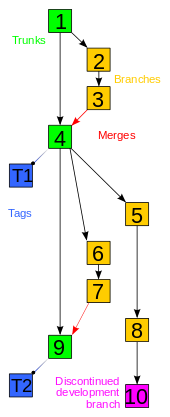Translation and Version Control
Introduction
[edit | edit source]This page about Translation and Version Control can be displayed as Wiki2Reveal slides. Single sections are regarded as slides and modifications on the slides will immediately affect the content of the slides. The following aspects of Translation and Version Control are considered in detail:
- (1) Version Control for content
- (2) Translation as a Fork of content from one language to another
- (3) Documentation of translate directions
Objective
[edit | edit source]This learning resource about Translation and Version Control in Wikiversity has the objective to link work on translations of Open Educational Resources with the concept of Version Control.
Version in single Language
[edit | edit source]
When you are active as author in Wikiversity, Wikipedia or in a MediaWiki in general you might know the history concept of articles in a Wiki.
Learning Activity
[edit | edit source]Look into the history of this page Translation and Version Control and see the different versions of the evolution of a learning resource. Explain how Version Control support collaborative work in a community.
Evolution of Learning Resource
[edit | edit source]Learning resources evolve over time and are improved by community members.
- Adding examples, images, animation, ...
- fixing typos.
- adding references,
- ...
Explain how collaborative effort in improvement of translations are visible in the history.
Fork in Software Development
[edit | edit source]A fork[1] in software development branches a current state of development and creates a new development path. An example could be
- Bubblebreaker webbased Game - https://niebert.github.io/bubblebreaker/
- which was forked from bobak7/bubblebreaker
- fork added a Hamburger Menu test for canvas based games and resizing the board according to screen size (e.g. mobile phones) which can be regarded in this context as an additional feature not present is the source version.
Forking - Different Use Cases
[edit | edit source]As in other cases of Open Source development, existing software resource (if they a licensed under an appropriate license) can be used to build new releases and versions from the given version, to add features or develop it further for another use case.
Application on Translations
[edit | edit source]A translation can be regarded as a fork[2] (similar to software development). Translation is a application of a Wikiversity learning resource in another context i.e. for another language target group.
Semantic of Source and Target
[edit | edit source]Even if the source and translation of the source in the destination language looks different, source and translated text should share the same semantic of the text in different languages. Nevertheless the translation could have some issues or the wording must be improved to be more comprehensible for the learners. This creates an evolutionary improvement in the destination language.
Community Participation
[edit | edit source]The community developing Open Educational Resources in the destination language have a cultural background and therefore some example might added and the wording might be improved. This creates in different branches new development process.
Translation direction
[edit | edit source]For cross-checking the semantics of source and destination language the translation source it might be indicated in the footer of learning resource, to validate and compare source and destination text.
Example
[edit | edit source]This is a translation of ... forked at ...data/time ...
Translate Tag
[edit | edit source]Assume the English Wikiversity learnning resource about Swarm intelligence is the source version for translation. The source is translated into a german version of Schwarmintelligenz, then a following tag can be inserted.
<span type="tanslate" src="Swarm intelligence" srclang="en" date="2020/03/24" time="16:34" status="inprogress"></span>
This tag would be inserted in the German translation to create a reference to the source version in the english Wikiversity.
Tag Type
[edit | edit source]The span tag is similar to the self-closing tag <reference/> for references in the Wikiversity sources. In contrast to reference tag a translate is not parsed so a span tag, because it will not destroy layout of the page.
Status of Translation
[edit | edit source]The translation status might be
- "inprogress" or
- "complete"
because translation could take some time to be finalized. This can be indicated in the span tag.
See also
[edit | edit source]References
[edit | edit source]- ↑ Nyman, L., & Mikkonen, T. (2011). To fork or not to fork: Fork motivations in SourceForge projects. International Journal of Open Source Software and Processes (IJOSSP), 3(3), 1-9.
- ↑ Robles, G., & González-Barahona, J. M. (2012). A comprehensive study of software forks: Dates, reasons and outcomes. In Open Source Systems: Long-Term Sustainability: 8th IFIP WG 2.13 International Conference, OSS 2012, Hammamet, Tunisia, September 10-13, 2012. Proceedings 8 (pp. 1-14). Springer Berlin Heidelberg.
See also
[edit | edit source]Page Information
[edit | edit source]You can display this page as Wiki2Reveal slides
Wiki2Reveal
[edit | edit source]The Wiki2Reveal slides were created for the Version Control' and the Link for the Wiki2Reveal Slides was created with the link generator.
- This page is designed as a PanDocElectron-SLIDE document type.
- Source: Wikiversity https://en.wikiversity.org/wiki/Translation%20and%20Version%20Control
- see Wiki2Reveal for the functionality of Wiki2Reveal.
